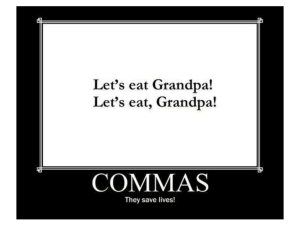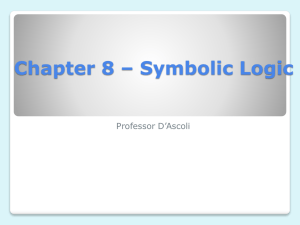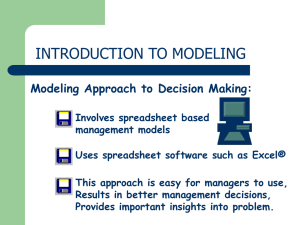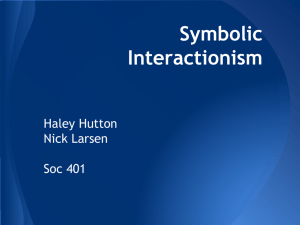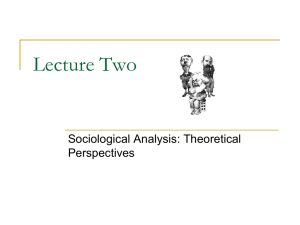extracting information from very extensive data sets
advertisement
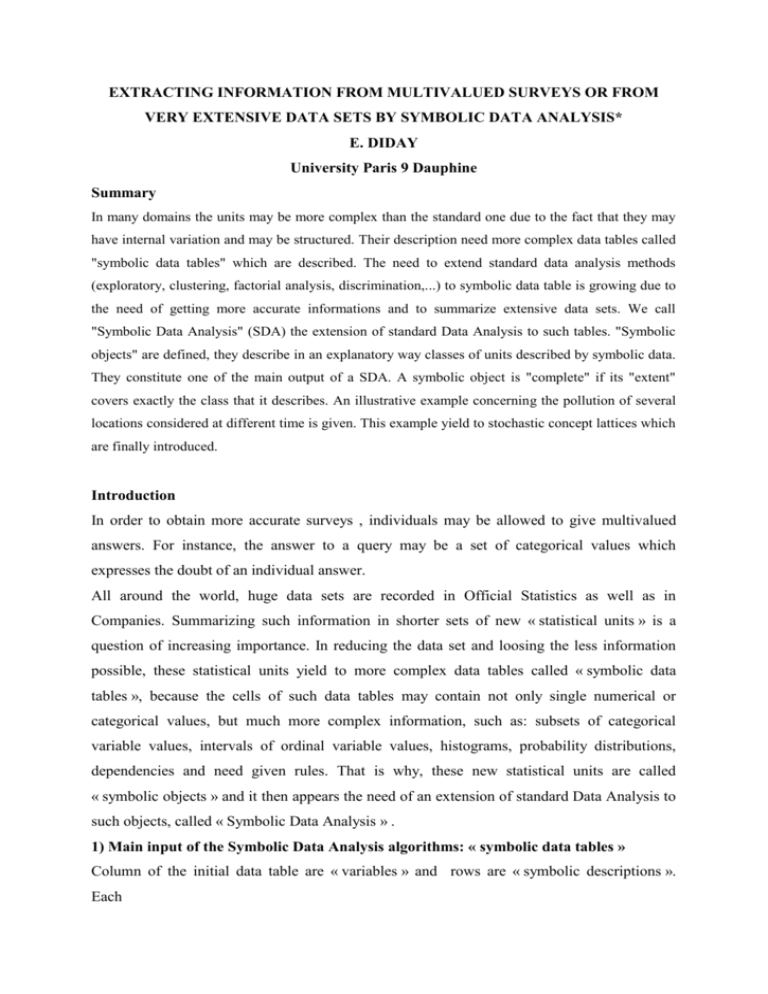
EXTRACTING INFORMATION FROM MULTIVALUED SURVEYS OR FROM
VERY EXTENSIVE DATA SETS BY SYMBOLIC DATA ANALYSIS*
E. DIDAY
University Paris 9 Dauphine
Summary
In many domains the units may be more complex than the standard one due to the fact that they may
have internal variation and may be structured. Their description need more complex data tables called
"symbolic data tables" which are described. The need to extend standard data analysis methods
(exploratory, clustering, factorial analysis, discrimination,...) to symbolic data table is growing due to
the need of getting more accurate informations and to summarize extensive data sets. We call
"Symbolic Data Analysis" (SDA) the extension of standard Data Analysis to such tables. "Symbolic
objects" are defined, they describe in an explanatory way classes of units described by symbolic data.
They constitute one of the main output of a SDA. A symbolic object is "complete" if its "extent"
covers exactly the class that it describes. An illustrative example concerning the pollution of several
locations considered at different time is given. This example yield to stochastic concept lattices which
are finally introduced.
Introduction
In order to obtain more accurate surveys , individuals may be allowed to give multivalued
answers. For instance, the answer to a query may be a set of categorical values which
expresses the doubt of an individual answer.
All around the world, huge data sets are recorded in Official Statistics as well as in
Companies. Summarizing such information in shorter sets of new « statistical units » is a
question of increasing importance. In reducing the data set and loosing the less information
possible, these statistical units yield to more complex data tables called « symbolic data
tables », because the cells of such data tables may contain not only single numerical or
categorical values, but much more complex information, such as: subsets of categorical
variable values, intervals of ordinal variable values, histograms, probability distributions,
dependencies and need given rules. That is why, these new statistical units are called
« symbolic objects » and it then appears the need of an extension of standard Data Analysis to
such objects, called « Symbolic Data Analysis » .
1) Main input of the Symbolic Data Analysis algorithms: « symbolic data tables »
Column of the initial data table are « variables » and rows are « symbolic descriptions ».
Each
* Published in "Advances in methodology, Data Analysis and Statistics" A. Ferlgoj Editor.
cell of this « symbolic data table » may contain data of different type:
(a) Single quantitative value : for instance, if « weight » is a variable and w is a unit :
weight(w)=3.5.. (b) single categorical value: for instance, Town(w)= London. (c) Multivalued:
for instance, in the quantitative case: weight(w)={3.5, 2.1, 5}which means that the weight of
w may be 3.5 or 2.1 or 5. In the categorical case, color(w) = {blue, red, yellow} means that the
color of w may be blue or red or yellow. Notice that (a) and (b) are special cases of (c). (d)
Interval: for instance weight(w)=[3, 5], which means that the weight of w varies in the interval
[3, 5]. (e) Multivalued with weights: for instance a histogram or a membership function
(notice that (a) and (b) and (c) are special cases of (e) when the weights are equal to 1).
Variables may be: (g) Taxonomic: for instance, « the color is considered to be light if it is
yellow, white or pink ». (h) Hierarchically dependent : for instance, we may describe the kind
of computer of a company, only if it has computer, hence the variable “does the company have
computers? “ and the variable “ kind of computer” are hierarchically linked. (i) With logical
dependencies: for instance, « if age(w) is less than 2 months then weight(w) is less than 10 ».
2) Main output of the Symbolic Data Analysis algorithms: complete symbolic objects
Let be a set of units called « individuals » , D a set of descriptions, « y » a mapping (called
attribute or variable) defined from in D, which associates to each w a description d
D from a given symbolic data table. We denote with R, a « comparison » operator between
two descriptions such that [d’ R d] L where L = {true, false} or L= [0,1]. For instance R
{=, , , , , ,, , , , an implication, a kind of matching, ...). A set of coherent
descriptions (for instance, the description: sex = male and number of deliveries = 1 is not
coherent), constitutes the set of objects on which any symbolic data analysis algorithm
applies. That is why, we call « object » any coherent description . If it is the description of an
individual, we call it, an « individual object ». It may be also the description of a class of
individuals, of a scenario, of a strategy, etc. . In the case of a survey, an individual object is a
coherent answer of an individual to the set of queries of the survey.
A « symbolic object » is defined by an object, a way of comparing it to individual objects
defined by a recognition mapping. The advantage of « symbolic objects » is at least of two
kinds. First, they give a summary of the initial symbolic data table in an explanatory way, (i.e.
close from the initial language of the user) by expressing descriptions based on the margin of
the initial variables. Second, by being independent from the initial symbolic data table, they
are able to identify any matching individual described in any data table . More formally, their
definition is:
Definition of a symbolic object
A symbolic object is a triple s = (a, R, d) where R is a comparison operator, d is a
description and « a » is defined from in L such that a(w) = [ y(w) R d].
There are two kinds of symbolic objects:
- « Boolean symbolic objects » if [y(w) R d] L = {true, false}. In this case, the y(w) are of
type (a) to (d), defined in section 1.
Example: d = {red, blue, yellow}, color(w) = {red, yellow}, R= « »,
a(w) = [color(w) d} = true.
- « modal symbolic objects » if [ y(w) R d] L = [0,1]. In this case, the y(w) are of type (e).
An example of choice for R is given thereunder.
Extent of a symbolic object s: in the Boolean case, it is defined by Ext(s) = {w / a(w) =
true}. In the modal case, given a threshold , it is defined by Ext(s) = {w / a(w) }.
Tools for symbolic objects: tools between symbolic objects (Diday (1995)) may be needed as
similarities, matching, merging by generalization where a « t-norm » or a « t-conorm »
(Schweizer, Sklar (1983)) or « capacities » (Diday, Emilion (1997)) may be used, splitting by
specialization (Ciampi et al. (1996)) . Let T be a merging operator, which associates a
description to a set of descriptions (for instance, the « sup » or the « inf » of such set). If the
choice of R and T is coherent, it may be shown that the underlying structure of a set of
symbolic objects is a Galois lattice (Polaillon, Diday (1997)), where the vertices are closed
sets defined by « complete symbolic objects ». More precisely, the associated Galois
correspondence (see Wille (1983), for instance) is defined by two mappings:
- F: from P() (power set of ) in S (the set of symbolic objects) such that F(C)= s where
s = (a, R,d) is defined by d = TcC y(c) and so a(w) = [y(w) R TcC y(c)], for a given R.
For example, if y(u) = {pink, blue}, C = {c, c’}, y(c)= {pink, red}, y(c’)= { blue,red}, and if
T({pink, red},{blue, red}})={pink, red, blue})and R « », then a(u)= true and u Ext (s).
- G: from S in P() such that: G(s) = Ext (s).
Complete symbolic object:
A symbolic object s is a « complete symbolic object » iff F(G(s)) = s.
These objects may be selected from the Galois lattice but also if the lattice is too large, from a
partitioning, a hierarchical or a pyramidal clustering, from the most contribute individuals to a
factorial axis, from a decision tree, etc. extended on symbolic objects in input and giving
complete symbolic objects in output.
Syntax of symbolic objects: if the initial data table contains p variables we denote
y(w) = (y1(w),..., yp (w)), D = (D1,...,Dp), d D: d=(d1,..., dp) and R = (R1,...,Rp). Then an
« assertion » is a special case of symbolic object defined by s = (a,R,d) and written as follows:
a(w) = i=1,p [ y i(w) Ri d i].
Individual symbolic objects, first and second order symbolic objects: any row describing
an individual « u » of a symbolic data table induces an assertion called « individual symbolic
object » by setting: a(w) = i=1,p [ y i(w) Ri y i(u) ] where Ri = « = » . Its extent is the set of
individuals of same description defined in the symbolic data table. Hence, if all the
individuals have different descriptions, there is a bijection between the set of individuals
defined in a symbolic data table, , and their associated individual objects or they associated
individual symbolic objects. That is why sometimes a row of a symbolic data table is called a
« symbolic object ». We distinguish « first order symbolic objects » (associated to individuals)
from « second order symbolic objects » which are associated to the description (obtained by
generalization) of a class of symbolic objects. For example, a second order Boolean assertion
object where SPC means « socio-professional-category » is: a(w) = [age(w) {12, 20 ,28}]
[SPC(w) {employee, worker}]. If the individual u is described in the initial symbolic data
table by y 1 (u)={12, 20 } and y 2 (u) = {employee } then its associated individual symbolic
object is:
us(w) = [age(w) = {12, 20 }] [SPC(w) = {employee }]. It results:
a(u) = [{12, 20 }{12, 20 ,28}] [{employee}{employee, worker}]and therefore a(u)=true.
If the variables are multivalued and weighted an example of assertion is:
a(w) = [age(w) R1 {(0.2)12, (0.8) [20 ,28]}] [SPC(w) R2 {(0.5)employee, (0.5)worker}]
where for instance the « matching of two probability distributions » is defined for two discrete
distributions r and q of k values by: r Ri q = j=1,k r j q j e (r j -
min (r , q ))
j j
.
3) Symbolic Data from where?
Symbolic data happen from many sources in order to summarize huge sets of data tables. They
result from the probability distribution , the percentile or the range of any random variable
associated to each cell of such data tables. They result also, from Relational Data Bases (in
merging several relations or summarizing the answer to a query), from surveys giving the
possibility of multivalued answers, from Data Analysis (factorial analysis, clustering, neural
networks, ...) of standard data table, from expert knowledge (scenario of traffic accidents, type
of unworkers, ...), from time series (in describing intervals of time), from confidential data (in
order to hide the initial data by less accuracy), etc.
4) An illustrative example:
The set of individuals in this example, is a set of locations in Paris (Eiffel Tower, Dauphine
University, Place de l’Etoile, ... ) considered at different times. We have two sets of variables:
the first Y1 concerns pollution (rate of lead, of CO2, ....). The second, Y2 is a set of
environment variables (density of cars, direction of the wind, ... ). Hence,we are in the case
of a huge initial data table which is described in Table1.
The question is expressed in the following way: find classes of locations with same behavior
in same environment conditions, describe them in a humanly comprehensible language,
organize them in term of this language, be able to allocate to these classes a new location.
study the evolution of these classes when the number of observations increases.
Y1: POLLUTION
Y2: ENVIRONMENT
y1
z1
yp
EIFFEL TOWER (T1)
.....
EIFFEL TOWER (Tn)
........
DAUPHINE (T1)
.....
DAUPHINE (Tk)
.....
Table 1: The initial data table
We propose the following method:
zp
1) Partitioning (with a good clustering algorithm) the locations x time described by the
pollution variables. The K classes of this partition are denoted: pol1, pol 2, ....... , pol K.
2) Partitioning (with the same algorithm) the locations x time described by the environment
conditions. We obtain L classes of locations x time denoted: env 1, env 2, ......
, env L.
3) We build the following data table 2 which associates to each location at each time a class of
pollution and a class of environment conditions
POLLUTION
ENVIRONMENT
TOUR EIFFEL(T1)
POL 9
ENV 4
TOUR EIFFEL(T2)
POL 5
ENV 7
POL 11
ENV 9
POL 5
ENV 9
POL 6
ENV 7
.....
TOUR EIFFEL(Tn)
........
UNIV.DAUPHINE(T1)
.....
UNIV.DAUPHINE(Tk)
Table 2: From a clustering algorithm, each location x time is associated to a class
characterized by pollution variables and to a class characterized by environment variables.
4) We build the histogram of pollution behavior for each location, for each class of
environment conditions. For instance, in the following data table 3 , we have K=4 , L = 3 .
The histogram contained in the first cell, defines for each class of pollution (Pol 1, Pol 2, Pol
3, Pol 4), the frequency of the Eifel Tower x time cases, in the first environmental class: env1.
In the graphical representation of each histogram, each class Pol i is associated to an interval
(see Graphic 1).
ENV 1
EIFFEL TOWER
DAUPHINE
ENV 2
ENV 3
UNIVERSITY
PLACE DE LA
CONCORDE
Table 3: Location behavior in three class of environment conditions.
Graphic 1: the level associated to the class Pol i of the histogram associated to a location and an environment
class Env j in table 3, is the number of time (obtained from tables 1 and 2) where this location is simultaneously
in the class Pol i and in the class Env j.
Having such a « context » defined by the triple: locations (the objects), environment classes
(the variables), histograms (the variable values), we are in the « symbolic data analysis
framework » where is a set of locations, y(w) = (h1 (w), h2 (w), h3 (w)) is an individual
object which describes the individual w, by three histograms, where hi correspond to the
variable yi. In other words, each individual object is a row of the preceding data table of
histograms. In order to describe a class C of locations we can use for instance a t-norm
denoted T such that:
T cC y(c) = (Max cC h1 (c), Max cC h2 (c), Max cC h3 (c)). The comparison operator is then
Ri = « », in order to be coherent with T. Hence, by using the notations given in 2, we have
F(C) = s where s = (a, R,d) is defined by d = TcC y(c) and a(w) =i=1,p [ y i (w) Ri TcC y i
(c)].
In other words a (w) = i=1,p [ h i (w) MaxcC h i (c)]. It results that the extension of s is
G(s) = {w / a (w) = true } = { w / i, h i (w) MaxcC h i (c ) }.
As in this case were R and T are coherent, F and G constitute a Galois correspondance. Each
node of the associated concept lattice corresponds to a complete symbolic object s:
F(G(s)) = s. This lattice defines all the complete symbolic objects associated with F and G.
5) Stochastic concept lattices.
5.1) Galois lattice of probability distributions
The basic frame of stochastic concept lattices is the following:
is a finite set of individuals ( for example, the set of « location x time » described by a pollution
class for each environment class). P is a probability measure defined on P(). is a finite set of
individuals (the locations). J is a finite set of indices (the variables: the environment classes). Oj is a
finite set (the pollution classes). (X i,j ) j J is a family of random variables from to Oj. For
example, X i,j (w) is the « class pollution » of the i th location at time w in the class environment j.
Let Li,j be the probability distribution of X i,j. We define the following symbolic object :
F(C) = (a, R, d) where Ri = « » , dc = [( Min c C Lc,j )j , (Max i C L c, j )j], and
a (w) = i=1,p [ Lw,j [( Min c C Lc, j )j , (Max c C Lc,j )j ] in other words:
a (w) = i=1,p [ [( Min c C Lc, j )j Lw,j (Max c C Lc,j )j ]. The following results may be
shown (Diday, Emilion (1997)):
Theorem 1
F and G are decreasing, h = GoF and k=FoG are increasing extensive and idempotent,
so that we get a concept lattice. In the case of a binary r.v. we get the usual binary concepts lattice.
5.2) Galois lattice of histograms:
Suppose that the Li,j are unknown but that we have at our disposal frequencies histograms Hi,j. We
can define the same kind of symbolic objects by using Hi,j instead of Li,j. Then we have:
Theorem 2
F and G yield a concept lattice and if moreover the frequencies histograms converge, then the
lattices defined by these histograms converge to that of the theorem1.
5.3) Galois lattice of support measures.
The closed support of the measure Lij is denoted by Sij .We suppose that we have got some
observations of the random variables Xi,j (n) sequence of r.v. such that the sequence of
vectors {Xi,j (n) i I }n is independent and distributed like the vector {Xi,j i I }.
The mapping F and G are defined as follows: F(C) = s such that s = (a, R, d) with
R = « », d = (i C Sij)j and a (w) = i=1,p [Swj i C Sij].
G(s) = {w / Swj Vj for all j} if d = ( Vj)j.
We have then the following result:
Theorem 3
As n goes to infinity, the step n - lattices converge to the Galois lattice induced by F and G.
As a consequence, the theorem 2 and 3 show that as the knowledge of the individuals
increases the concepts focus and converge.
6) An example of lattice:
The initial symbolic data table is given in table 4. It may be obtained in a stochastic lattice
context, from the support of each probability distribution L i j or histogram H i j or from a given
percentile.
y1
y2
y3
1
a,b
g
2
g,h
3
c
e,f
g,h,i
4
a,b,c
e
h
Table 4: The initial symbolic data table
With T and R , the complete symbolic objects denoted si = ( a i , , di ) and their
extension obtained by using an extension of the Chein algorithm (Diday (1996), Pollaillon et
al. (1997)) are the following:
a1 (w)= [y1 (w) O1 ] [y2 (w) O2 ] [y3 (w) O3 ], Ext(s1 ) = {1,2,3,4}
a2 (w)= [y2 (w) {e} ] [y3 (w) {g,h} ], Ext(s2 ) = {1, 2, 4}
a3 (w) = [y1 (w) {c} ], Ext(s3 ) = {2, 3}
a4 (w) = [ y1 (w) {a,b} ] [ y2 (w) = ] [ y3 (w) {g,h} ], Ext(s4 ) = {1, 2}
a5 (w)= [y2 (w) {e} ] [y3 (w) {h} ], Ext(s5) = {4}
a6(w) = [ y1 (w) {a,b} ] [ y2 (w) = ] [ y3 (w) {g} ], Ext(s6 ) = {1}
a7 (w) = [ y1 (w) = {} ] [ y2 (w) = ] [ y3 (w) {g,h} ], Ext(s7 ) = {2}
a8 (w) = [ y1 (w) = ] [ y2 (w) = ] [ y3 (w) = ], Ext(s8 ) = { }
Figure3 Galois Lattice of the symbolic objects defined in table 1.
7) Conclusion
A general aim of a symbolic
data analysis may be settled in the following way: having as
input: (, D, y, T, R), find complete symbolic objects. But as in statistics, the underlying
lattice becomes often too large, other methods which provide also symbolic objects have to be
used. The need to extend standard data analysis methods (exploratory, clustering, factorial
analysis, discrimination,...) to symbolic data table is growing due to the expansion of
information technology. This need, yields to an European Community project called SODAS
(Hebrail (1996)) for a « Symbolic Official Data Analysis System» in which 15 institutions of 9
European countries are involved.
BIBLIOGRAPHY
Ciampi A., Diday E., Lebbe J., Périnel E., Vigne (1995) R. " Recursive partition with
probabilistically imprecise data". OSDA'95. Springer Verlag (1996).
Diday E., Emilion R. (1995) "Lattices and Capacities in Analysis of Probabilistic Objects".
Proceed. of OSDA'95 (Ordinal and Symbolic Data Analysis). Springer Verlag Editor (1996).
Diday E., Emilion R. (1997) " Treillis de Galois maximaux et capacités de Choquet". Compte
Rendu à l’Académie des Sciences. Paris, T. 324, Série1. Elsevier Academic.
Diday E. (1995) " Probabilistic, possibilist and belief objects for a knowledge analysis " . Annals
of Operations Research . 55, 227-276.
Diday E. (1996) " Une introduction à l’analyse des donnees symboliques " Proc. SFC, Vannes,
France.
Hebrail G. (1996) " SODAS (Symbolic Official Data Analysis System) ". Proceedings of
IFCS’96, Kobe , Japan. Springer Verlag.
Pollaillon G., Diday, E. (1997) " Galois lattices of symbolic objects " Rapport du Ceremade
University Paris9- Dauphine (february).
Schweizer B. , Sklar A. (1983) " Probabilistic metric spaces ". Elsever North-Holland, NewYork.
Wille R. (1983) " Subdirect decomposition of concept lattices " Algebra Universalis.
